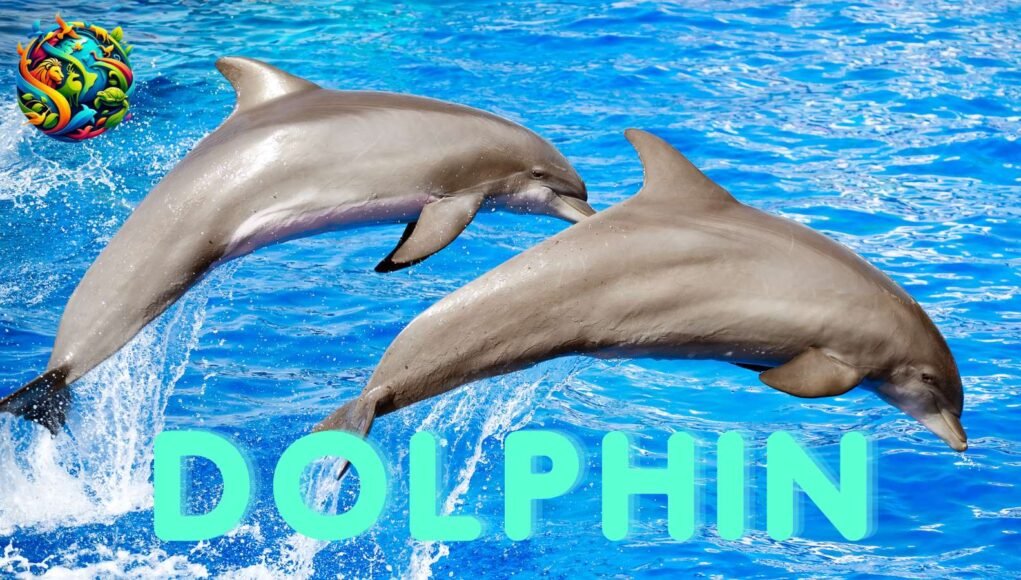Dolphin: The Intelligent and Playful Marine Mammal
Introduction:
They are among the most intelligent and social marine animals, known for their playful behaviour and complex communication. These aquatic mammals belong to the family Delphinidae and are closely related to whales and porpoises. Found in oceans and some freshwater rivers across the globe, they play an essential role in marine ecosystems. Their fascinating behaviour, advanced cognitive abilities, and interactions with humans make them one of the most studied and admired animals in the world.
Amazing Facts:
- Echolocation Experts: They use echolocation to navigate, hunt, and communicate, allowing them to detect objects in murky waters.
- Highly Social Creatures: They live in pods, with some species forming superpods consisting of hundreds of individuals.
- Exceptional intelligence: They can recognise themselves in mirrors, solve problems, and even exhibit cultural behaviours.
- Fast and Agile Swimmers: Some species, like the common dolphin, can reach speeds of up to 37 mph (60 km/h).
- Complex Communication: They produce clicks, whistles, and body movements to communicate with one another.
- Helpers of the Sea: They have been observed assisting injured pod members and even interacting positively with humans.
Habitat and Diet:
Their inhabit a diverse range of environments, from the open ocean to coastal areas and even freshwater rivers.
Habitat:
- Oceans and Seas: Most species prefer warm, temperate waters, such as the Atlantic and Pacific Oceans.
- Coastal Waters: Some species, like the bottlenose dolphin, thrive in shallow coastal areas.
- Freshwater Rivers: The Amazon and Ganges river dolphins live exclusively in freshwater ecosystems.
Global Distribution
- Found in nearly every ocean, from tropical waters to colder regions like the Arctic and Antarctic.
- Certain species, such as the orca (killer whale), have the broadest distribution, found from polar to tropical waters.
Diet:
They are carnivorous predators with varied diets depending on their species and habitat.
Primary Food Sources
- Fish: The primary diet for most species, including mackerel, herring, and sardines.
- Squid and Cephalopods: A preferred food source for deep-sea species.
- Crustaceans: Some species consume shrimp and other small marine creatures.
- Occasionally Hunting Together: They use cooperative hunting techniques, such as creating bait balls or using bubble nets to trap prey.
Appearance:
Their exhibit a streamlined body shape adapted for fast swimming and agile movement.
Size and Weight
- Smallest Species: The Maui dolphin measures about 4 feet (1.2 meters) and weighs around 90 pounds (40 kg).
- Largest Species: The orca, or killer whale, reaches up to 32 feet (9.8 meters) and can weigh over 12,000 pounds (5,400 kg).
Skin and Coloration
- Typically smooth skin with colours ranging from grey, blue, and black to white or spotted patterns.
- Many species have countershading, a darker back and lighter belly, helping with camouflage in the water.
Notable Features
- Dorsal Fin: A stabilising fin on the back, varying in shape and size among species.
- Pectoral Flippers: Used for steering and agile movement.
- Blowhole: Located on top of their head, allowing them to breathe at the surface.
How They Communicate:
They are highly social animals, displaying complex behaviours and strong bonds within their pods.
Pod Structure
- Small Pods: 5–15 individuals, common in species like bottlenose dolphins.
- Superpods: Hundreds of them may gather in areas with abundant food.
- Matrilineal Groups: Some species, like orcas, live in family-based groups led by older females.
Communication Methods
- Clicks and whistles: Each has a unique signature whistle used for individual identification.
- Body Language: Leaping, tail slapping, and head-bobbing convey different messages.
- Echolocation: Helps in navigation, detecting objects, and hunting.
Predators and Threats:
Although they are skilled at evading predators, they still face natural and human-induced threats.
Natural Predators
- Sharks: Large shark species, such as the great white and tiger sharks, prey on dolphins.
- Orcas: Although they are also dolphins, orcas sometimes hunt smaller dolphin species.
Human-Induced Threats
- Fishing Industry: Bycatch in fishing nets leads to accidental dolphin deaths.
- Pollution: Plastic waste and oil spills negatively impact their habitat.
- Climate Change: Rising ocean temperatures and changing fish populations affect their survival.
- Hunting: Some regions, like Japan and the Faroe Islands, have controversial dolphin hunting traditions.
Mating and reproduction:
They have relatively long lifespans and invest significant parental care in their offspring.
Mating and Gestation
- Mating Season: Varies by species, but many breed year-round.
- Gestation Period: Ranges from 10 to 18 months, depending on species.
- Birth: A single calf is born tail-first to prevent drowning.
Parental Care
- Mothers nurse their calves for up to two years.
- Calves stay with their mothers for several years to learn survival skills.
Movies Featuring Dolphins:
They have been featured prominently in films, books, and television, showcasing their intelligence and playful nature.
Famous Dolphin-Themed Movies and Shows
- Flipper (1963, 1996, 2020): A classic series and film about a friendly dolphin helping humans.
- Dolphin Tale (2011, 2014): Based on the true story of Winter, a dolphin with a prosthetic tail.
- The Cove (2009): A documentary exposing dolphin hunting practices in Japan.
- Finding Dory (2016): While not featuring dolphins as main characters, the film highlights marine conservation themes.
How “Dolphin” Is Pronounced in Different Languages:
- English: Dolphin (/ˈdɒl.fɪn/)
- Spanish: Delfín (/delˈfin/)
- French: Dauphin (/do.fɛ̃/)
- German: Delfin (/ˈdɛl.fiːn/)
- Mandarin Chinese: 海豚 (Hǎitún)
- Japanese: イルカ (Iruka)
- Russian: Дельфин (Del’fin)
FAQs:
Q: How smart are dolphins?
A: They are among the most intelligent animals, capable of problem-solving, self-recognition, and complex social interactions.
Q: Do they sleep?
A: Yes, they sleep by shutting down one half of their brain at a time while still remaining semi-alert.
Q: Are they friendly to humans?
A: Yes, many species exhibit curiosity and often interact playfully with humans.
Dolphins continue to amaze scientists and ocean lovers alike, highlighting the need for their protection and conservation.




